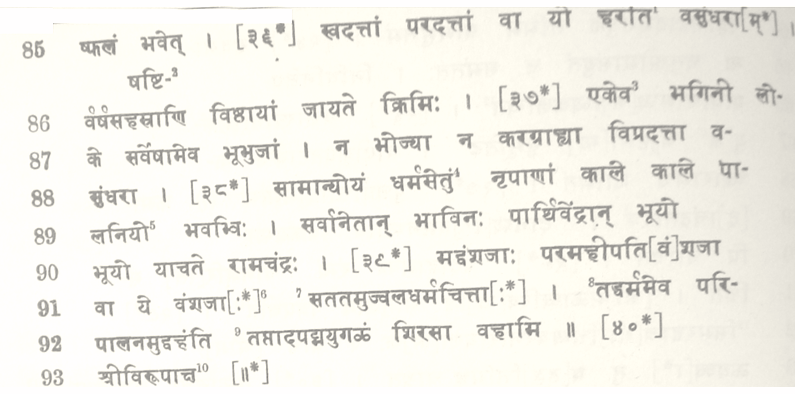|
The Indian Analyst
|
North Indian Inscriptions |
NALLUR GRANT OF HARIHARA II.
TRANSLATION. ......(Line 1.) Let there be prosperity ! Obeisance to the blessed Gaṇâdhipati ! ......(Verse 1.) Adoration to Śaṁbhu (Śiva), who is the adorned, as with a châmara, with the moon that is kissing (his) lofty head, (and) who is the principal pillar at the building of the city (which consists) of the three worlds ! ......(V. 2.) Let it protect you,― the staff-like tusk of Hari (Vishṇu), who disported himself as a boar, (placed) on which (tusk) the Earth resembled a parasol, with the golden mountain (Mêru) as it point ! ......(V. 3.) I make obeisance to Vighnêśvara (Gaṇapati), the remover of obstacles, whose feet are dyed yellow by the mass of the stamina of golden lotus-flowers. ......(V. 4.) Let it always bring you prosperity,― the body of Vishṇu, the primeval Boar, who carries on the tip of (his) huge tusk the Earth along with Śrî (Lakshmî) !
......(V. 5.) Obeisance to that Boar, on whose graceful tusk rests the Earth !― On this (earth) (are performed) sacrifices by good men who know the meaning of the Vêdas ; by these (sacrifices) the gods are pleased ; the head of the race of these (gods) (is) Hari (Indra) ; to him (Indra) belong the clouds ; these (clouds) pour forth rain ; by rain all creepers and grain grow ; (and) by these, the men created by Pitâmaha (Brahmâ) are gladdened. ......(V. 6.) There was (produced) the Moon, who supports the life (of the inhabitants) of the three worlds, who appears to be an incarnation of joy, (and who is) the chief ornament on the diadem of Paramêśvara (Śiva). ......(V. 7.) In his (the Moon’s) race, there was a glorious ruler of the earth, (called) Yadu, after which praiseworthy (king) the descendants of the race of the Moon are (also) called Yâdavas. ......(V. 8) In this praiseworthy race of Yadu was born that glorious lord Saṁgama, by whom all subjects were protected according to the ancient rules. ......(V. 9.) The lotus of his fame had the golden mountain (Mêru) for its seed-vessel, (and)
the great Mandâkinî (Gaṅgâ) river for a stream of honey.
| ||||||||||||||||||||||||||||||||||||||||||||||||||||||||||||||||||||||||||||
| > |
|
>
|









